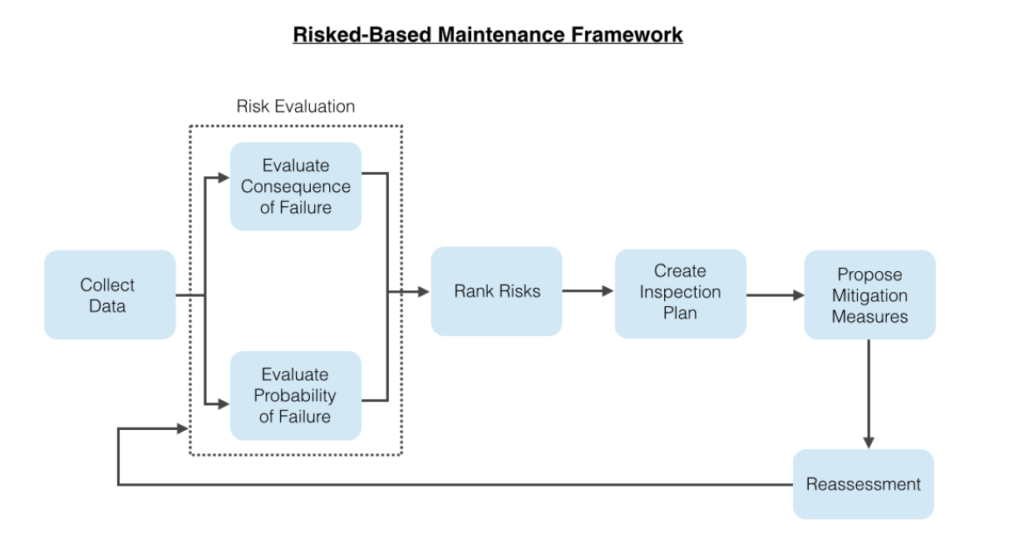In today’s day and age, FM providers have realised that early identification of risk and mitigation of its side effects are key when it comes to providing efficient services. More and more businesses across the world are now partnering with FM providers that implement a risk-based thinking model (i.e. have ISO 9001:2015 certification).
What Is Risk-based Maintenance?
In the realms of facility management, risk-based thinking prioritizes the asset with the highest probability of failure. These assets are monitored and maintained more frequently than others. By choosing which asset to repair and when, the model minimizes the risk of failure in the most cost-effective way possible.
How Do You Implement Risk-based Maintenance?
Risk-based maintenance is implemented in two phases:
- The assessment of the risk depends upon the likelihood of failure carried by an asset. There is no one method to assess the severity of the risk. A variety of deterministic and probabilistic approaches are used by FMS providers and organizations to estimate the likelihood of failure. Whatever the method may be, accurate identification and analysis of risk are crucial to ensuring the successful outcome of risk-based maintenance strategies.
- Planning a maintenance strategy based on risk assessment. A maintenance strategy is a systematic approach that determines the appropriate maintenance plans. The maintenance plans are based on a variety of factors that constitute the risk-based maintenance framework.

The workings of risk-based maintenance framework:
- Collection of data: Once the risk is identified, data of all sorts including details of the risk, its effects, and mitigation are collected.
- Risk evaluation: At the evaluation stage, the risk and its consequences are quantified to be measured.
- Rank risks: The data obtained from the quantification of risk probability and its consequences is combined to determine the ‘total risk’. Total risk is then compared with predetermined levels of risk which indicates whether a risk is acceptable or not.
- Creating an inspection plan: If the risk is not found to be within acceptable levels, a plan is developed to inspect the system via condition based monitoring.
- Propose mitigation measure: To mitigate the risk, a proposal is planned via condition based monitoring and predictive maintenance approach.
- Reassessment: Once the proposal is developed, it is assessed for legal and regulatory requirements. If it does not match the criteria, the plan is developed once again otherwise the maintenance proposal is put into place.
Business Continuity Plan In Facility Management
A Business Continuity Plan (BCP) is a process which outlines the potential impact of a disaster, includes steps to be taken in case of an unanticipated event that might cause disruption to the business and helps businesses revolver quickly.
What can be considered an “emergency” in facility management?
A situation can be termed as an emergency in the realms of facility management when business cannot continue as per usual. Examples of emergency situations at facilities include natural disasters, compliance breach, intruder oit active shooter, cyberattack, employee injury or change in the chain of command.
Why is BCP important?
Consider a scenario where the operations of a business are brought to a standstill by an emergency. Disruptions in business lead to higher revenue and increased costs which affect profitability. Yes, insurance might cover some of the costs incurred but not all of it. With BCP in place, your organization will be better prepared to mitigate the adverse effects of the disaster and have a strategy to achieve the set goals after the disruption.
So, how do you build a Business Continuity plan?
Form a business continuity team. At the very least your business continuity team must include a manager, an assistant manager and an administrative assistant from each department. The makeup of the team can vary depending on the organization’s size and how they plan to implement the BCP program.
Carry out business analysis. To identify the potential risks an emergency may pose to the organization, it is essential that the BCP team carries out Business Impact Analysis (BIA). Once the risks are identified, the team must analyze the threats and come up with procedures that could combat the aftermaths of the disruption.
Find out the discrepancies in the operation. There might be a gap in the resources you currently have and the ones you will need when a major disruption occurs. Ensure that you have the adequate resources in place to tackle the effects of the disaster.
A structured risk analysis and mitigation framework in place reduces the severity and impact of potential failures drastically thus saving the business from a colossal loss. There’s no reason as to why FM providers and organizations must not adopt a risk-based analysis model.
Want to partner with an FM provider that implements a risk-based thinking delivery approach? Look no further than VAR. To know more about our services.
Related Post
Related Post
Sign Up to Get Latest Updates
About Us
Contact Us
Phone No. – 080 4146 4792
Email Id – info@varfms.com
